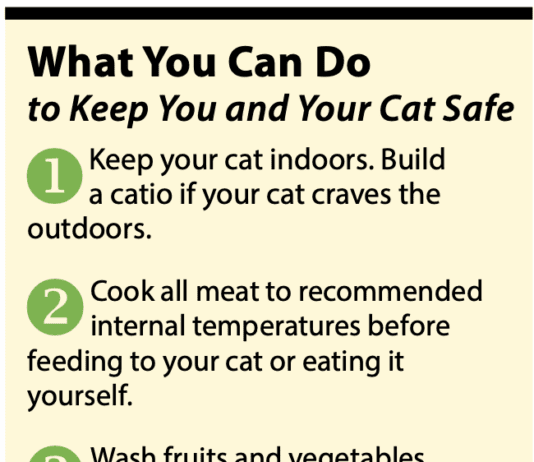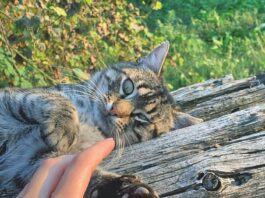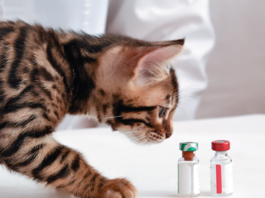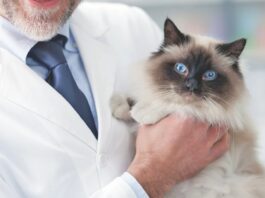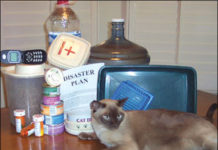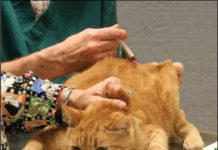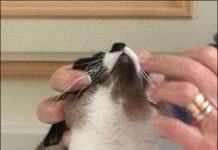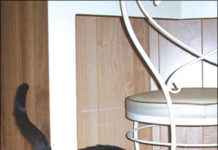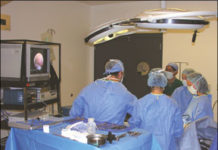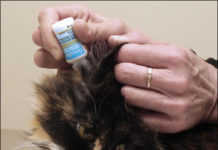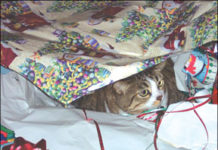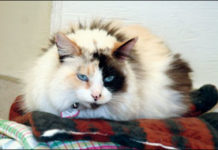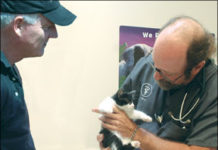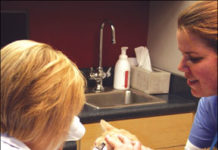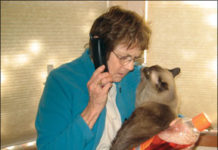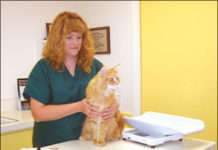Pet Owner Fire Safety Tips
When an out-of-control firestorm raced through the hills above Santa Barbara, California, last fall, frantic residents had little time to grab a few belongings and flee. "My wife and I were able to safely evacuate with our dogs and one of our cats," remembers Jason Bryan, a resident of Montecito, a tiny enclave of Santa Barbara. "Unfortunately, our other cat, Sunny, is adept at hiding, and we couldnt find him before we had to leave. For days, the Bryans lived in a cramped motel room and were forced to wait and wonder whether their house - and beloved cat - had survived the flames. On the fourth day, they were allowed to return to their burned out neighborhood. "Miraculously, our house was still standing," says Marian, Jasons wife. "And best of all, we found Sunny inside, hungry and lonely, but alive. We feel truly blessed." Some were not as fortunate as the Bryans. Sabrina Robinson was just finishing up her workday at a medical supply company when the fire broke out shortly before 6:00 pm on that fateful day. She wasnt aware of the imminent danger until she stepped outside and smelled the acrid smell of smoke.
When to Vaccinate Your Cat
During the past half-century, no fewer than 10 vaccines have been developed that, according to their manufacturers, can protect your cat against a wide variety of lethal feline diseases. In general, these claims of efficacy have been justified. According to Fred Scott, DVM, PhD, professor emeritus of virology at Cornell Universitys College of Veterinary Medicine and the founding director of the Cornell Feline Health Center, the vaccines have been responsible for "a tremendous improvement in feline health." He cites as a prime example the vaccine created to protect against the feline panleukopenia virus (FPV). "Prior to the late 1960s and early 1970s," says Dr. Scott, "half of all cats that passed through a shelter developed panleukopenia within a few days - and as many as 90 percent of them died from it. Today, the FPV vaccine has totally controlled the disease in properly vaccinated cats. The only time you see it now is in unvaccinated feral or farm cats or those that are in shelters, but that is rare." However, he points out, there are several reasons why owners should refrain from having their cats inoculated annually with every available vaccine. For example, it is remotely possible for a vaccine to damage a developing fetus or stimulate an allergic reaction. And of growing concern is the development of vaccine-associated sarcoma - a type of cancer that, for unknown reasons, emerges at the site on a cats body where a vaccine has been injected. Furthermore, research has brought into question the need for all cats to be routinely revaccinated with all available vaccines every year throughout their lives. Certain laboratory tests may reveal that, as the result of a previous vaccination or natural exposure to an infectious agent, the antibody levels in a cats blood remain high enough to protect it against a specific virus or bacterium. In that case, the animal would be protected against disease associated with that infectious agent and a booster shot would be unnecessary.
Medicating Your Cat
For many pet owners, the realization that a cat will require medicating - even for just a few days - is enough to cause serious apprehension. Though some felines are extraordinarily good when it comes taking their medicine, others are not. Cats can be notoriously difficult to capture, restrain and medicate; however, with the following expert tips, medicating a cat can be much less stressful - for both cat and owner. "One of the biggest stumbling blocks for cat owners is the mindset with which they approach medicating their cats," explains Jodi Korich, DVM, the director of Partners in Animal Health at Cornell Universitys College of Veterinary Medicine. If you are nervous about medicating your cat or perhaps youre feeling incredibly worried because your kitty is ill, your cat will pick up on this. "You have to approach medicating your cat with the mindset that you are doing this for the cats own good, working calmly, quickly and not obsessing over the process," recommends Dr. Korich. A positive, confident approach may make your cat feel more secure.
Is it Urinary Incontinence or Urine Marking?
When a cat begins soiling the house, it is usually assumed that it is a behavioral problem or the onset of senility. However, there are several medical conditions that can cause urinary incontinence and inappropriate urination, some of which require immediate treatment. First, it is important to distinguish between incontinence and inappropriate urination. True incontinence occurs when a cat does not have voluntary control over urination; trauma, a weak primary sphincter muscle and congenital abnormalities are the most common causes of incontinence. Inappropriate urination is much more common than true incontinence; this may be a behavioral problem or it may be the result of an underlying medical condition. The most common medical cause of inappropriate urination is inflammation of the urinary bladder. While the root causes often vary significantly, the signs - called lower urinary tract signs or LUTS - are similar: frequent urination, excessive licking of the genital area and difficult or painful urination. The actual diagnosis can range from a urinary tract infection to urethral blockage. It is extremely important to seek veterinary care if your cat exhibits these signs - do not assume that the animal is simply constipated. If he is suffering from urethral blockage, he may lose consciousness and die within a day or two of complete blockage. On the other hand, it may turn out to be something as treatable as a urinary tract infection. To begin with, your veterinarian may ask several questions...
Laparascopic Surgery
Your normally active cat isnt eating well, and shes suffering from intermittent vomiting and diarrhea. You make an appointment at the veterinary clinic and during the exam, your veterinarian recommends a liver biopsy to determine exactly whats going on. Sounds simple enough, but taking a biopsy requires that your cat be placed under general anesthesia and her abdomen cut open so the veterinarian can take a small sample of the liver. Afterward, the wound is sutured and your cat must remain in the hospital for a day or two for observation, all the while receiving medication to alleviate her post-operative pain. In the past, this was the typical scenario for all exploratory surgeries in the abdominal region of a cats body. Today, with advances in veterinary medicine, veterinarians have access to a revolutionary surgical technique called laparoscopy - a minimally invasive medical procedure that is being used with increasing frequency for a variety of diagnostic and surgical purposes. The technology is a giant step forward for the veterinary surgical field, according to James Flanders, DVM, an associate professor of surgery at Cornell Universitys College of Veterinary Medicine. "Traditionally, veterinarians would perform an open surgery, where we make a large, mid-line incision in the abdomen in order to look inside and do whatever we need to do, whether its to take a biopsy of the liver or to remove bladder stones. Now, with the laparoscope, we only need to a few small incisions (each one about a half-inch in length). Because the incisions are so tiny, the animal experiences far less post-operative pain and recovers faster."
Feline Ear Disorders
Among a normal, healthy, and properly cared-for cats many distinctive attributes is its astoundingly acute sense of hearing. While the human auditory system is capable of detecting sounds ranging in frequency up to about 20,000 vibrations per second, cats typically can sense sounds pulsating at 60,000 vibrations per second or greater. This impressive acoustic sensitivity has been honed over the ages to serve a cat in countless ways - signaling the stealthy approach of a dangerous predator, for example, or detecting the underground movement of a burrowing rodent. Although most cats will go through life without experiencing a serious problem with their ears, owners should know that a variety of conditions - including congenital defects, infections, trauma and age-related changes - can be extremely painful and may compromise an animals hearing. Most feline ear disorders are readily treatable and will not result in permanent hearing loss, notes James Flanders, DVM, an associate professor of surgery at Cornell Universitys College of Veterinary Medicine. However, some conditions may render a cat partially or totally deaf, especially if they remain unrecognized and untreated.
The Danger of String
Brooke Remy of Boston, MA, was delighted to watch her cat Puddles play with a long, pink ribbon she had just taken off a gift box. He twirled around and around and rolled over on the floor. Brooke tired before Puddles did, and left the room for about five minutes. When she returned, the ribbon was gone - except for about two inches sticking out of Puddless mouth. He was coughing and drooling. Running over to him, Brooke began slowly pulling the ribbon out of his mouth, watching in terror and amazement as she removed eight inches of wet pink ribbon from his throat. Puddles was lucky that Brooke had returned in time. If he had swallowed the ribbon without Brookes quick intervention, he could have suffered very serious, even life-threatening, damage to his intestinal tract.
Is Your Aging Cat Seeking Attention?
These days, despite what we like to consider modern conveniences, people commonly complain that they just cannot find the time to get a good nights sleep. So much to do, so little time. When we finally do settle into bed, we like to be left to our dreams, undisturbed until the alarm takes us to tomorrow. Noisy neighbors, construction crews and barking dogs are beyond our control. But, what an unexpected, and unpleasant, surprise to be awakened by ones own cat! Restless behavior may be particularly hard to understand when your cat has spent the first 12 years of his life refusing to leave the covers until a decent sunbeam appears. The first time that a senior cats cries call a person from sleep, there may be a sympathetic response. A naturally concerned owner might check the food supply. The next occurrence will be more puzzling. Clearly the cat is not wanting for food. Could there be another cat in the yard? Maybe a critter got into the house?
Short Takes: 11/08
A recent report in the Journal of the American Veterinary Medical Association provided encouraging reassurance that lessons were learned from the tragic melamine contamination of pet food in 2007. Several of the investigators in the study "Clinicopathologic, histologic, and toxicologic findings in 70 cats inadvertently exposed to pet food contaminated with melamine and cyanuric acid" (JAVMA Vol. 233, No. 5) were from Cornell, where the New York State Animal Health Diagnostic Center did some of the groundwork that led to the largest recall of cat and dog food in U.S. history. The 70 cats in this study were not privately owned, nor were they laboratory cats that were deliberately fed suspect food to see if theyd get sick. Rather, they were 70 animals (from a licensed commercial cattery) that happened to be engaged in scientific diet-preference studies when the melamine contamination problem hit the national news. It was their good luck, however, to be where expert veterinary medical care was immediately at hand.
Feline Vision Problems: A Host of Possible Causes
Owing to several unique features developed over centuries in the wild, the modern cat typically possesses powerful visual acuity that enables it to function effectively both indoors and beyond the confines of its home. Unfortunately, the feline ocular apparatus is vulnerable to injuries and a wide variety of diseases that can dramatically impair a cats eyesight or, worst case, render it partially or totally blind. "We see cats that are either blind or going blind several times a week," says Thomas Kern, DVM, associate professor of ophthalmology at Cornell Universitys College of Veterinary Medicine. "Most of these animals have eye disease as a primary disorder - they have no other health problems. And most of them are middle-aged or elderly cats whose vision loss has been progressing for years." As is true for virtually all threats to feline health, the earlier a cats vision problem is diagnosed, the more effectively it can be treated - unless, of course, the animals blindness has progressed irreversibly by the time it is noticed. Therefore, Dr. Kern urges owners to keep an eye out for any behavioral or physical indications that a cat is having a vision problem and to report any such signs to a veterinarian without delay.
Finding Emergency Care
Perhaps the most important characteristic of a responsible cat owner is the ability to distinguish the signs of minor feline illnesses from those calling for an immediate trip to the nearest animal emergency care facility. Cat owners should be equipped ahead of time to deal promptly with such a crisis. They should know precisely where the clinic is located, the speediest route to get there, how to transport the afflicted animal, what documents they should take to the facility - and what to expect to happen upon arrival. Feline emergency cases are by no means rare, says Gretchen Schoeffler, DVM, chief of emergency and critical care services at the Cornell University Hospital for Animals (CUHA). She and her colleagues typically treat as many as 10 or 15 severely ill cats each week in the hospitals emergency unit, which, like most such facilities in the U.S., is open 24 hours a day, seven days a week.
Help Calm Anxiety at the Vet’s Office
Isnt it remarkable that most cats are well-behaved when they visit their veterinarians? First, they are captured and put into an automobile. They remain in their containers, sheltered but helpless, in a room filled with the scent of unfamiliar cats, humans and even dogs. Finally, every bit of security is lost when the cat is removed from its newfound shelter and the veterinary team places the cat on the examination table. Why do cats behave so nicely? Fear can sometimes render a cat motionless and therefore cooperative. Fearful cats - whether immobile or aggressive - can benefit from a behavior modification specifically designed to address high arousal. But what about the average cat, dare I say the "normal" cat? There may be no indication for intensive therapy or anxiety-reducing medication. But clearly, the veterinary experience is not entirely stress-free. Rather than take a cats good behavior for granted, why not reduce some of the stressors that can occur during a visit to the veterinary hospital? Lets examine some components of the visit that could trigger anxiety.

